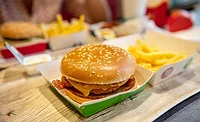Restaurant Tech: What You Can Expect to See More of in 2016

An estimated 73 percent of restaurant owners plan on using new business technology in the upcoming year. With an increase in apps, devices and new tools available, the opportunities for upgrades are endless. By upgrading to new technology, restaurateurs can improve customer satisfaction, streamline the running of the business and boost revenue.
Priorities Centered Around Energy Savings
On average, here is how restaurants energy bill spending is allocated:
- 35 percent on cooking
- 28 percent on heating and cooling
- 18 percent on washing dishes
- 6 percent on refrigeration
By using back-of-house energy-efficient tools, restaurants can lower their energy bills by up to 5 percent.
 As energy usage becomes even more of a priority in a growing eco-aware society, ENERGY STAR® products are starting to take center stage. Rethinking the type of dishwasher, oven or energy recovery system in place can save big time on overhead costs. Entire systems have been designed to operate around heat recovery. In this style of system, the heat that is created by the dishwasher's used water or the refrigerator’s condensing unit is reused to preheat air and water. This one technique alone can reduce energy usage by 15 percent.
As energy usage becomes even more of a priority in a growing eco-aware society, ENERGY STAR® products are starting to take center stage. Rethinking the type of dishwasher, oven or energy recovery system in place can save big time on overhead costs. Entire systems have been designed to operate around heat recovery. In this style of system, the heat that is created by the dishwasher's used water or the refrigerator’s condensing unit is reused to preheat air and water. This one technique alone can reduce energy usage by 15 percent.
For smaller energy consumption changes, restaurateurs can save money through light-emitting diode (LED) lighting. Using LED lights inside reach-in coolers or display cases cuts down on energy usage and also lowers replacement costs. In addition, built-in timers for items like icemakers can lower off-peak energy usage. With a controller and a built-in timer, the device can be set to turn off during off-hours for impressive cost savings.
The Commercial Kitchen App
With technology like the Commercial Kitchen app, users can use mobile devices, tablets and mini-computers to run everything that is going on in a commercial kitchen. It streamlines the order- taking process using pre-created forms. The customer has to finalize the order before it is sent through to the Commercial Kitchen app’s management portal for the kitchen staff to use.
In the kitchen, the app is designed to assign dishes to specific cooks and chefs. Without having to yell out orders, the app sends the information to the head chef who can delegate parts of the order to other chefs. Other than managing the cooking and ordering process, this app can also help with invoicing. In the management portal, sales staff can look at all of the order information and create invoices for customers at the restaurant.
Inventory Management
One of the latest trends in restaurant kitchens is toward inventory management. New software programs and apps make it easier to track supplies and order replacements. These inventory systems allow chefs to immediately get ingredients that are in stock. This saves money, time and effort for the average chef.
Looking for quick answers on food safety topics?
Try Ask FSM, our new smart AI search tool.
Ask FSM →
The Hottest Trend for Customers: Digital Menus
This hot, new trend is being implemented in fast-casual, high-end and fast food restaurants. With this technology, management can flexibly update menus in seconds. It allows service speeds to improve and saves on labor costs. The technology is quickly being adopted at restaurants across the country. Many of the interactive digital menus incorporate algorithms into their software, allowing the menu to recommend wine pairings, side dishes and promotions that work with specific dishes.
Dennis Smolek of Showman, an interactive signage company, recently gave us his take on the industry and what’s to come.
“Digital signage is becoming essential as electronics become more affordable and interactive technology more commonplace. By raising both perception and engagement, digital menus prove they are more than just nice videos and pretty pictures. From marketing campaigns to hourly promotions, digital menus capture attention and influence customer decisions with an average 32 percent increase in sales. Last year saw some amazing innovations like kiosks to answer the call for smaller staffs and deaf-friendly drive-thrus with video chats. As technology continues to permeate our lives, customers and visitors will come to expect it wherever they go.”
As Dennis hints, the fact that technology is increasingly becoming more prevalent in our lives, tech-friendly patrons will come to expect these everywhere, including restaurants of all sorts.
Changing Sizes
With the rise of food trucks, satellite kitchens and pop-up restaurants, kitchens are only growing smaller. As kitchen sizes decrease, equipment must be optimized for the smaller space. A combi-oven can be an ideal option for small spaces because it can cook and steam without taking up a lot of counter space. In the front-of-house, self-service equipment has been recreated to be smaller, taller and narrower.
Electronic Scheduling
In recent years, the trend to electronically schedule employees has increased significantly. By switching from paper documents, restaurateurs can make it simpler to set and review schedules. In addition, it eases the process of changing shifts and asking for time off for employees. Timesheets, tip reporting and overtime can be easily tracked electronically to make for a smoother running business.
Mark Feldman, chief technology officer at FindMyShift.com, sheds some light on why scheduling online is advantageous for many restaurants.
“As restaurants small and large become more comfortable with integrating web apps into workflow, agile capabilities to track schedules grows in popularity. This is especially important with restaurants with multiple locations that allow employees to take shifts at their other locations on the fly, or has regional trainers for new openings. Without software to keep things organized in an updated cloud solution, shifts can easily be missed.”
Integrating Media
With so many technological tools and advancements, restaurants need a way to integrate the various types of technology. New apps make it easier to integrate signs, orders and electronic menus into one platform. By using these platforms, operators can easily update the music, menus, messages and displays in their restaurants.
All of these technologically advanced tools are designed to simplify the process of running a restaurant. From ensuring that dishes have been delegated properly to improving the scheduling process, technology can increase the efficiency of modern restaurants. Over the course of the next decade, these trends will become the norm for successful establishments willing to evolve.
Atlantic Training is a safety training company based in Delaware. They provide training videos and presentations for companies in industries such as hospitality, healthcare, supply chain, construction and more. Learn more at AtlanticTraining.com.








